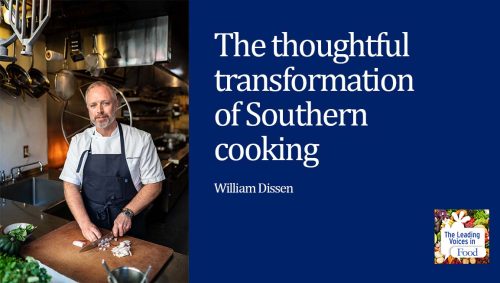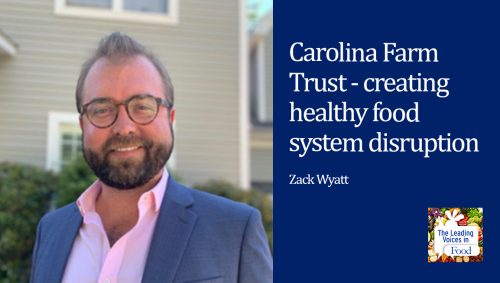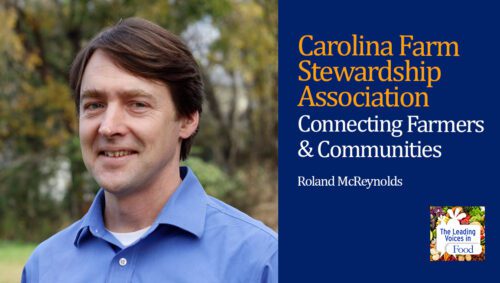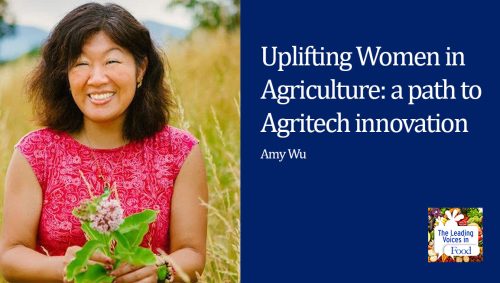The Leading Voices in Food
E58: Pig Farming Family Style at Razorback Farms
It’s August in North Carolina and I’m here with Marlowe Vaughan and her father Bob Ivey at Razorback Farm, a family-owned pig farm in Goldsboro.
Subscribe: Apple Podcasts | TuneIN | YouTube Music | SoundCloud | PocketCasts | Radio Public
Tags: Agriculture & Tech | North Carolina | Voice of Farming |

Marlowe Vaughn is a fourth generation farmer in Wayne County, North Carolina, and has farmed pigs for about 10 years with her father, Bob Ivey. Ivey has been part of the industry since 1979. Together, they run Razorback Farm, which is about 80 acres of row crops here that are rotated to work with their manure management system. They have 10 finishing floors in the last stage of production, meaning the hogs that come to this form are the hogs that go to market.
Interview Summary
Welcome to The Leading Voices in Food podcast, an educational series produced by the World Food Policy Center at Duke University. I’m Deborah Hill. You are listening to a segment in our voice of farming series.
It’s August in North Carolina and I’m here with Marlowe Vaughn and her father Bob Ivey at Razorback Farm, a family-owned pig farm in Goldsboro.
My name is Marlowe Vaughn and I’m a fourth generation farmer in Wayne County, North Carolina. I’m a pig farmer and we’ve owned this pig farm for about 10 years.
I’m Bob Ivey. I’ve been in the industry since 1979. I got in the pig business to enable me to come back to the family farm because we were mainly tobacco farmers and row crop farmers. So the pig business was a way for me to accomplish that, and my brother also. And it’s really gratifying to see that now my daughter and her brother are interested in coming back and being part of the farm too. So it’s been really a great experience through the years.
[Vaughan] This farm is about 80 acres. So we do row crops here that we rotate to work with our manure waste management system. We have 10 finishing floors in the last stage of production, meaning the hogs that come to this form are the hogs that go to market. So they come here at about 45 to 50 pounds and then I raise them to about 280. And then that’s when they go to market.I’m sweating in the knee-high plastic boot covers and the coveralls required for entering the hog house, and it’s a relief to step inside where the temperatures are much more comfortable. I can’t help but smile as I watch Marlowe Vaughan move through the hog house, leaning down to touch a few pigs as they nose their way up to her out of curiosity. She’s tall and lean and dressed in a red cover suit with black knee-high mud boots. Her long blonde hair is pulled into a ponytail under her matching red NC State hat and she’s wearing pearl earrings.
[Vaughan] So, I’m a contract farmer, so that means that I grow pigs for another company. And so they have their specific guidelines, but we raise the pigs for them. When I’m walking the barns, animal health is always our top priority. A happy, healthy pig is a prosperous pig. And I think people have this misconception that we’re producing these fast turns of vast animals, but every hog is different. We always look specifically at each hog when we roll up the barns and just check if they’re eating, if they’re drinking, how they’re feeling that day. And you know, that’s something that as a farmer, and I can speak for most hog farmers, that we take pride in is the health and happiness of our hogs. So that’s what we kind of do. While they’re here, they’re pretty healthy most of the time. They get a cold or cough and we treat them with a veterinarian specifically for that animal on our farm. So we work very closely with veterinarians on animal health. [Ivey] So the main flow of how the pigs come from the integrator is they have farms that they have, either they own the farms or they have them under contract with people that specialize in raising baby piglets. And they raise those piglets to about 20 days of age to 21 days of age and they weigh about 13 or 14 pounds. And from there they are moved to a nursery and they stay in the nursery for about six and a half weeks in a cycle. And they’re given special diets. They change the diet multiple times in the nursery, because just like your child when you’re taken off of breast milk or off of formula and changing it over, that they go through the same situation. The integrator has specialized diets to make that transition really smooth and healthy for the pig.And as Marlowe was saying, the pig stays here. And these nurseries are typically owned by people that are under contract, and they have a special contract with the integrator just to raise the pigs to the 45 or 50 pounds that Marlowe was talking about. And then they’re moved here. And then from here, as she was saying, they’re finished out and taken to the plants to be harvested. And typically the ones that are harvested in eastern North Carolina go to Smithville.
One of the great things about being part of an integrated system as a contractor is you don’t have the market risk. You don’t have to worry about all the stress of what the pig prices are. So it’s really comforting to have a business model where … you know, farming, you worry about whether it rains or whether it doesn’t rain, and in this case it’s a steady stream of cash flow. So this farm was built, I think it was built in the ’90s, probably about ’93 or ’94. And of course back then the hog industry was really growing and it was built to specifications of the integrator, and also the soil and water and the environmental agencies were very involved in regulating how the lagoon was built and the acres that are needed and all that. So it’s a very heavily regulated industry and it’s evolved a lot through the years.
These barns are tunnel ventilated, which means there’s a bank of fans at one end of the farm and then there’s either louvers that bring the air in through the ceiling that’s preheated in the wintertime or there’s a curtain at the other end and it creates a wind tunnel. And you know, they say, “sweat like a pig,” well, pigs really don’t sweat. Also in the barns they have these foggers that mists water on the pigs so when it’s really hot like it is today, the fans evaporate that air off the pig and it really cool them down.
All of this is controlled by computers and the computers can monitor the air and it also can change the ventilation daily. Especially in the wintertime as the pigs grow, we know what the growth curve is so they can increase so many CFM per pound of body weight so they get the perfect amount of air so they can stay healthy and comfortable. So the computers are really a big, important part of the swine industry and there’s a lot of work been done and have the perfect environment available for that pig.
[Vaughan] We do group housing with our hogs, so our hogs are in groups, but like he said, we started out on the ground and we moved them inside barns for a reason. It helps protect the pig immensely from … I mean, we’re in North Carolina, it could be a 100 degrees today or a snow storm tomorrow. So it really protects them from the elements and predators and other issues that we deal with. And pigs are actually very social animals and they’re actually herd animals. So when you walk into our barns, you can see the hogs in their specific groups. And we have worked very closely with veterinarians and other researchers that have looked at the science behind how much room these pigs actually need for their specific growth, so that’s how we have determined the space they need now. [Ivey] The big thing about the building design is to keep the pigs happy. If the pigs are happy they’re going to stay healthy, they’re going to do well. And just like in the barn that you went and visited, as the pigs get crowded, you just thin them out and sell a load, you know, the ones that grow a little faster. So you can really control the density just by getting in there and getting the biggest ones out of each pen and giving them some more space. And there’s a lot of science to how not only the space of the pigs, but also how they’re fed. In these barns here, I think the diets are changed now about six times. And so the integrator works really hard on using the latest technology for feed. By changing those diets they can match up the amino acids and the other nutrients necessary for the pig with its growth curve.And the advantage of that is that by not overfeeding protein, you’re not excreting nitrogen, which goes into the lagoon and it’s a problem for the environment. And when we grew hogs on the ground, they rooted up the trees, they rooted up the soil. The flies were horrible because when it rained and you had a mud hole, you had manure. These houses are designed to remove the manure on a regular basis. And because this goes into solution a lot, the larvae cannot develop and so that really helps with the flies.
And the other things with the technology that have been really interesting is not only the use of amino acids, which lowers the output of nitrogen, but also the use of an enzyme called phytase. And it lowers the amount of phosphorus that comes out of the manure by about 25% or 30%. And that’s good for the environment, and it does that by making what’s naturally in the plant that was unavailable before, available to the pig by using this enzyme.
So there’s a lot of technology that’s being used to reduce the load of nitrogen and phosphorous to the system, as far as the manure going into the lagoon, and also a pig today compared to the ones that I raised out on the ground, they probably had a 3.5 to 4 feet conversion. Now we’ve got those de-conversions down to 2.4. And so it’s taken 150, 200 pounds less feed to get that pig to the same market. That helps the carbon footprint. So a combination of health, genetics, feed, all those things really reduce the carbon footprint, make things a lot more efficient and environmentally friendly. So good story here that’s seldom told.
[Vaughan] As a millennial farmer, I think that’s one of our top concerns. And I think that kind of goes for every new farmer getting in the business, our environmental footprint and our carbon footprint. And I think over the past 30 years, we’ve decreased that by 40%. Not only if you think that’s a huge testimony to my dad, but a huge testimony for what we look forward in the future as a millennial farmer. [Ivey] One of the things that is really cool is when you saw Marlowe walking through the buildings, she was touching the pigs, rubbing them, interacting with the pigs. Farmers love their animals. It’s good to see your child do that because she’s a good mother too, so she treats her pigs just like she treats her children. And she’s very concerned during the hurricanes and those type things. When a lot of people were at home and off the roads, we came out here and checked on the animals. Say I don’t have a generator at my house, but we have them at our farms to keep them safe and comfortable. So it’s really fun to watch the farmer interact because you can tell that they love their animals and they care for their wellbeing. And the pigs, as you noticed, they didn’t run to the back of the pen, they came up and they wanted to see what was going on and kind of say hello. So it’s really fun to see that passed along to another generation, so I like that a whole lot.








